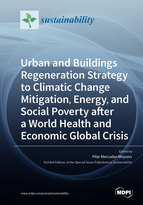Urban and Buildings Regeneration Strategy to Climatic Change Mitigation, Energy, and Social Poverty after a World Health and Economic Global Crisis
A special issue of Sustainability (ISSN 2071-1050). This special issue belongs to the section "Hazards and Sustainability".
Deadline for manuscript submissions: closed (31 August 2021) | Viewed by 28746
Special Issue Editor
Interests: artificial intelligence and sustainability; sustainable renovation of buildings; neighborhood regeneration; circular economy; decarbonization of the construction sector; sustainable construction; eco-efficient constructive solutions; resource efficiency in architecture, engineering, and urbanism
Special Issues, Collections and Topics in MDPI journals
Special Issue Information
Dear Colleagues,
In recent months, we have suffered the effects of an unexpected global health crisis that has led to an even worse global economic crisis, with GDPs plummeting to unprecedented levels. While our health workers struggle to find a vaccine to protect our health, we have had to live through situations hitherto unimagined, and we have spent even more time in our homes while our streets remained empty, which has brought to light the weaknesses and strengths of our system and our way of building and designing.
Our aim is to publish research projects and papers that contribute to reactivate the Construction Sector from within, in the context of this world economic crisis. Such an effort will focus especially on solutions that improve the quality of indoor air in buildings, strengthening the circular economy in an eco-efficient rehabilitation of buildings and neighborhoods in our cities.
Prof. Dr. Pilar Mercader-Moyano Manuscript Submission Information
Manuscripts should be submitted online at www.mdpi.com by registering and logging in to this website. Once you are registered, click here to go to the submission form. Manuscripts can be submitted until the deadline. All submissions that pass pre-check are peer-reviewed. Accepted papers will be published continuously in the journal (as soon as accepted) and will be listed together on the special issue website. Research articles, review articles as well as short communications are invited. For planned papers, a title and short abstract (about 100 words) can be sent to the Editorial Office for announcement on this website. Submitted manuscripts should not have been published previously, nor be under consideration for publication elsewhere (except conference proceedings papers). All manuscripts are thoroughly refereed through a single-blind peer-review process. A guide for authors and other relevant information for submission of manuscripts is available on the Instructions for Authors page. Sustainability is an international peer-reviewed open access semimonthly journal published by MDPI.
Please visit the Instructions for Authors page before submitting a manuscript.
The Article Processing Charge (APC) for publication in this open access journal is 2400 CHF (Swiss Francs).
Submitted papers should be well formatted and use good English. Authors may use MDPI's
English editing service prior to publication or during author revisions.
Guest Editor
Keywords
- economic crisis
- circular economy
- decarbonization of the construction sector
- refurbishment of buildings
- neighborhood regeneration
- eco-efficient construction solutions
- construction and waste management
- indoor environmental quality
- resource efficiency






